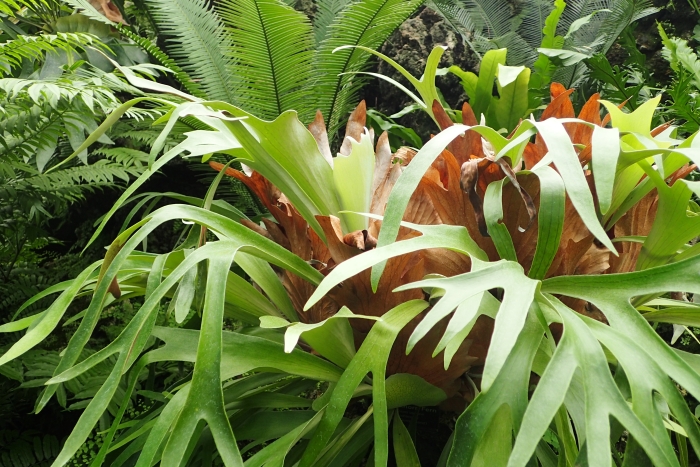Elkhorn Fern
(Platycerium bifurcatum)
Elkhorn Fern (Platycerium bifurcatum)
/
/

Krzysztof Ziarnek, Kenraiz
CC BY-SA 4.0
Image By:
Krzysztof Ziarnek, Kenraiz
Recorded By:
Copyright:
CC BY-SA 4.0
Copyright Notice:
Photo by: Krzysztof Ziarnek, Kenraiz | License Type: CC BY-SA 4.0 | License URL: https://creativecommons.org/licenses/by-sa/4.0 | Uploader: Kenraiz | Publisher: Wikimedia Commons | Title: Platycerium_bifurcatum_kz01.jpg | Notes: |












































Estimated Native Range
Summary
Platycerium bifurcatum, commonly known as Elkhorn Fern, is an epiphytic evergreen fern native to the rainforests of Eastern Australia and New Caledonia. It typically grows on tree trunks and branches, absorbing moisture and nutrients from the air and rain. This fern can reach up to 90 cm (35 in) in height and 80 cm (31 in) in width. Its distinctive fronds resemble the antlers of an elk, contributing to its common name. The fertile fronds are green and flat, while the sterile fronds are brown and form a shield-like base. Elkhorn Ferns do not produce flowers or seeds, instead reproducing via spores located on the underside of the fertile fronds.
Elkhorn Fern is valued for its unique appearance and is often used as an ornamental plant in gardens, especially in hanging baskets or mounted on trees or boards to mimic its natural epiphytic growing conditions. It has earned the Royal Horticultural Society’s Award of Garden Merit, indicating its excellence for garden use. It thrives in part shade with medium water requirements and prefers well-draining soil or an epiphytic substrate. While it can tolerate temperatures down to 5 °C (41 °F), it should be protected from frost. In temperate regions, it is commonly grown as a houseplant. Care should be taken when growing Platycerium bifurcatum outside its native range, as it can become invasive, particularly in areas like Florida.CC BY-SA 4.0
Elkhorn Fern is valued for its unique appearance and is often used as an ornamental plant in gardens, especially in hanging baskets or mounted on trees or boards to mimic its natural epiphytic growing conditions. It has earned the Royal Horticultural Society’s Award of Garden Merit, indicating its excellence for garden use. It thrives in part shade with medium water requirements and prefers well-draining soil or an epiphytic substrate. While it can tolerate temperatures down to 5 °C (41 °F), it should be protected from frost. In temperate regions, it is commonly grown as a houseplant. Care should be taken when growing Platycerium bifurcatum outside its native range, as it can become invasive, particularly in areas like Florida.CC BY-SA 4.0
Plant Description
- Plant Type: Fern
- Height: 2-3 feet
- Width: 2-3 feet
- Growth Rate: Slow
- Flower Color: N/A
- Flowering Season: Non-Flowering
- Leaf Retention: Evergreen
Growth Requirements
- Sun: Part Shade
- Water: Medium
- Drainage: Fast
Common Uses
Deer Resistant, Drought Tolerant, Low Maintenance, Potted Plant, Rabbit Resistant, Rock Garden
Natural Habitat
Rainforests of Eastern Australia and New Caledonia
Other Names
Common Names: Common Staghorn Fern , 鹿角蕨
Scientific Names: Platycerium bifurcatum , Platycerium bifurcatum var. normale
GBIF Accepted Name: Platycerium bifurcatum (Cav.) C.Chr.